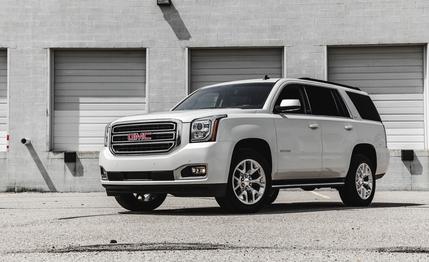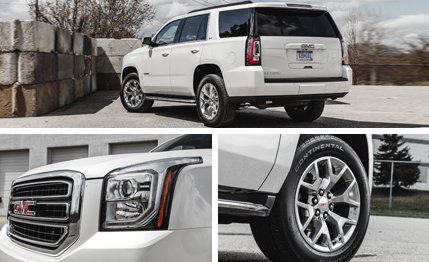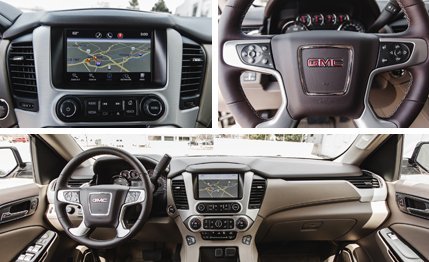
 Instrumented Test
Instrumented Test
When it's a matter of go big or stay home, the first question becomes “how big is enough?” At GMC stores, the latest available answers are the new for 2015 Yukon and Yukon XL. The latter casts a shadow 20 inches longer than the standard edition tested here, which yields 28-percent-more luggage capacity and 10-inches-more legroom for the third-row seats.
The regular-length Yukon costs less to buy, drinks less fuel, maneuvers into smaller garages, and, with less of its own mass to manage, actually boasts somewhat higher maximum payload and towing capacities. So, could you settle for just under 100 cubic feet of cargo space and reserve the third row for short trips or short people? The Yukon even offers a Denali variation that'll put a 420-hp, 6.2-liter V-8 under the hood, giving GMC something the Chevy Tahoe doesn't offer.


When right-sizing your SUV, though, consider the standard 5.3-liter EcoTec3 V-8 making 355 horsepower. We tested a four-wheel-drive Yukon SLT with this engine coupled to the six-speed automatic (the only transmission offered). It arrived at 60 mph in 6.8 seconds and got through the quarter-mile in 15.3 at 92 mph, respectable figures for a family sedan—let alone a big utility that weighs 5698 pounds. Expect a Denali to pare more than a second off that 0-to-60 time, likely at the cost of fuel economy. We saw a real-world 16 mpg driving hard in the SLT, spot on the EPA city rating; the window sticker’s EPA combined rating of 18 mpg looks reachable.
A base rear-drive Yukon SLE starts at $47,330. Equipped with four-wheel drive (a $3000 bump on any Yukon), the starting price on our SLT test truck was $58,730. The SLT adds a Driver Alert package (collision and lane-departure warnings, with alerts via seat vibration), heated and cooled seats for the first two rows, a leather-wrapped and heated steering wheel, and power adjustable pedals that, with the tilting-and-telescoping steering column, yield lots of adjustability for drivers of varying stature.
Adding the Sun and Entertainment package ($3255, with a power sunroof, premium audio system, navigation, and rear-seat entertainment) and the Theft-Deterrent package ($395) qualified for a $500 discount on the options list. Our test model also had 20-inch polished aluminum wheels ($1400), White Diamond tricoat paint ($995), the Max Trailering package ($650, with 3.42:1 rear axle replacing the standard 3.08:1, brake controller, and Z85 suspension with self-leveling rear air springs), and power operation for the second-row buckets ($590). All in, the $65,515 bottom line didn't reach the $66,675 starting price for a 4WD Denali, to which you'd have to add more than $4000 to get the rear-seat entertainment system and sunroof.


Of course, this truck didn't have the Denali’s 6.2-liter V-8 or wood trim in the cabin, and the cocoa leather interior trimmings were a single color rather than two, but we never felt like cheapskates in its lush environs. Its 8200-pound tow rating is a couple hundred better than that of a like-equipped XL, and it's a nice truck to drive. Improvements for 2015 include acoustical insulated glass that reduces noise (our test gear measured only 66 decibels at 70 mph and 73 at wide-open throttle) and a stiffened frame that helps smooth the ride. No one expects a rig like this to handle like a sports car, but the Yukon does feel nimbler than its long-wheelbase XL brethren. The new model's electric-assist steering returns little feel but responds more sharply and directly than the steering in GM’s previous-generation full-size SUVs, and its 0.77 g of lateral grip is 0.05 g better than we saw in a test of the 2007 Yukon Denali.
For buyers not interested in driving a nearly 17-foot-long, almost-three-ton SUV around, there are plenty of smaller crossover alternatives that offer a more carlike ride as well as better fuel economy and maneuverability. Sales of traditional, truck-based full-size SUVs have softened for every player in the class, but some customers still lead lifestyles that demand this kind of people-carrying, cargo-toting, and trailer-towing abilities. For many of those buyers, any lesser SUV just wouldn’t suffice.